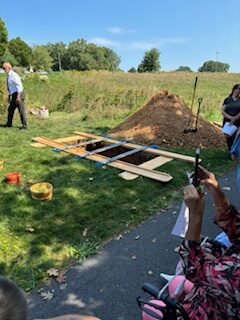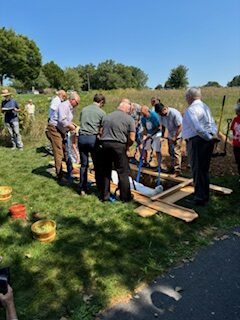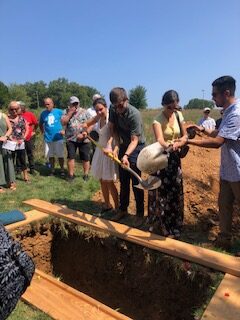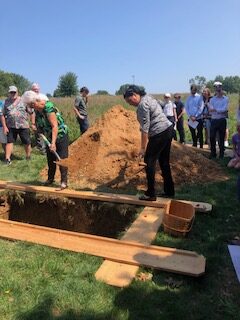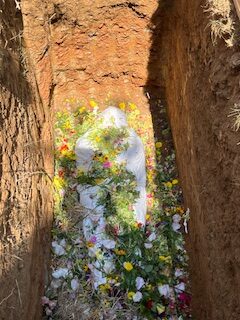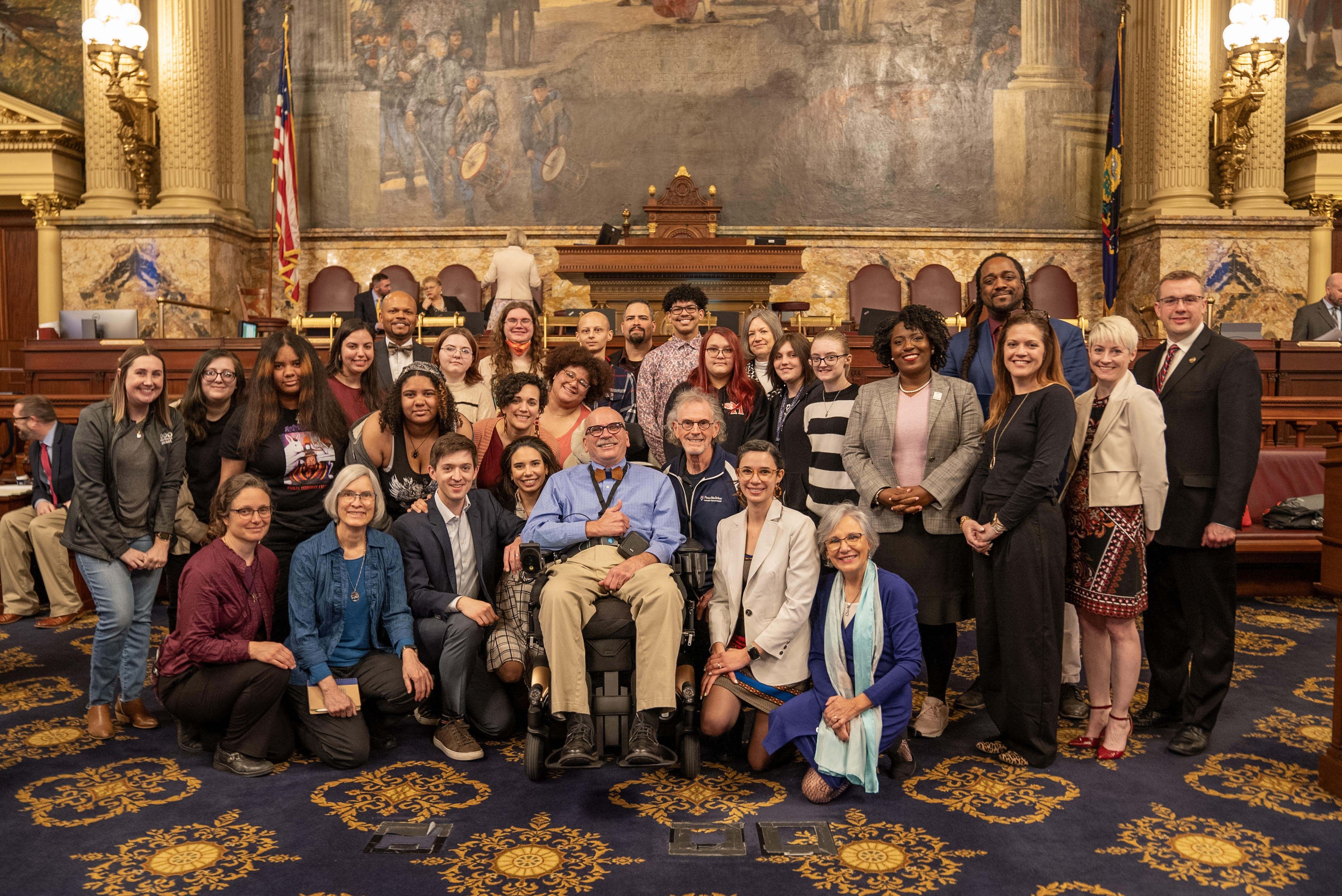
Brother Frank Albrecht was laid to rest on a clear, blue morning last August, wrapped in a white shroud and covered in flower petals and grass clippings beneath the shade of the Akron Mennonite pines.
The beloved School District of Lancaster educator, known for his decades of peacemaking work at McCaskey High School, died 15 months after being diagnosed with Lou Gehrig’s disease. His wife, Elizabeth Soto Albrecht, said the green burial provided a final teachable moment in how to express love for our dear ones while caring for the Earth.
“I feel the green burial provided my heart a peaceful and beautiful way of grieving,” Soto Albrecht said.
The green burial process allowed Soto Albrecht to cleanse her husband’s body in their house, a ritual that combined Christian and Muslim traditions to provide a moment of communion in which she honored the person who’d been her partner for more than 35 years.
Albrecht founded Reach, a student-led afterschool club focusing on positive mental health practices, and established the school district’s mediation program to promote conflict resolution among students, faculty and staff. His memorial fund also supported a tree-planting project at McCaskey.
Albrecht’s funeral proved a joyful sendoff, and Soto Albrecht encourages others to educate themselves about green burial options and consider whether that path could also be the right one for their families.
Green burials are still rare enough that funeral directors who support the practice often need to start by simply defining what it means.
Bill Spence, funeral director at Simple Funerals Inc. in Manheim Borough, said many people have an easier time defining what they don’t want: a public viewing, embalming and an expensive casket. Many of his clients also express discomfort with the concept of cremation, Spence said.
Green options can include foregoing embalming, using a shroud instead of a casket, or employing a burial container that is turned upside down to let the body be in contact with soil while maintaining the integrity of the grave.
Families concerned about the environmental impact of funeral practices note that cremation involves the burning of fossil fuels and can be an emissions-intensive process.
Greener practices range from formaldehyde-free embalming to green-certified caskets that eschew metal in favor of materials like wood, seagrass or wicker. Natural shrouds can be made of cotton or linen.
Spence said he’s seen a significant number of people looking for alternatives who react positively to the idea of a green burial.
Green burials are less expensive, which can mean that funeral homes are not interested in highlighting those options, Spence said, urging interested families to ask their funeral provider what green options can be made available.
Pennsylvania law does not require caskets or vaults, but many cemeteries set their own requirements, Spence said.
Akron Mennonite has been offering green burials for about five years and has had seven in the last two years, said John Weber, chair of the Akron Mennonite Church Cemetery Association, a seven-member cemetery committee that facilitates burial services for members of Mennonite congregations and neighbors who live within three miles of the church.
Green burials are one part of Akron Mennonite’s efforts to emphasize the spiritual cycle of life.
The church has developed a four-acre nature preserve planted with native trees and grasses that includes walking paths and benches. There are no bodies buried in the preserve, but it abuts the cemetery and ashes can be spread there.
“Our interest is in connecting life and death and a beautiful demonstration with the native grasses and pollinators,” Weber said.
The Terre Hill cemetery, now borough-operated after being formerly run by the St. Paul’s United Methodist Church, is another Lancaster County location that recently started supporting green burials.
Cemetery trustee Dixie Adams said she’s all for promoting green burials because of the high cost of funerals.
Funeral homes that promote expensive caskets also promote vaults to protect the cost of those caskets, Adams said. The Terre Hill cemetery does not require vaults.
Concrete vaults are needed to support the weight of a traditional casket, but there are other effective ways to manage a cemetery, said Dave Morrison, co-trustee of the Lampeter Green Burial Ground.
The historic Quaker cemetery has been open to the general public for the last decade. Its green burials typically involve placing a shrouded body on a board, lowering it by ropes into the ground and then covering it with leaves and dirt.
Subsidence is the term for the gradual lowering of ground that occurs in such natural burials, and the Lampeter Green Burial Ground hosts a volunteer day each spring in which volunteers add dirt, mulch and grass seed to help maintain grave sites.
Green burials have been an option at the Charles F. Snyder Funeral Homes for almost 20 years, but they still form a very small part of the company’s overall business.
Company president Chad Snyder said green burials are less than 1% of the burials the funeral homes facilities through its seven Lancaster County locations.
Snyder said their funeral home probably performs the most green burials in the county but that only amounts to a handful annually.
“In my mind, the folks that have a green burial are not necessarily looking to save money,” Snyder said, calling it an honorable way to be buried.
Charles F. Snyder Funeral Homes is a member of the Green Burial Council.
GBC President Darren Crouch said he feels that U.S. consumers are ready for more green options but that the funeral industry has been really slow to change.
As eco-friendly practices have become mainstream, people are seeking to honor and celebrate their loved ones in a different way, Crouch said.
Traditional vaults create cemeteries that resemble manicured lawns, and there’s still a level of anxiety around learning how to handle natural burial grounds that have different maintenance needs, Crouch said.
The industry is changing as many funeral directors reach retirement, Crouch said, predicting that green burials will become more prevalent as more funeral homes and cemetery operators become comfortable with the practice.
That moment under the pines has stayed bright in Soto Albrecht’s memory. She has no doubt a green burial was the proper sendoff for her husband.
“The freshness of the earth, of the soil - it felt so natural to be embraced by Mother Earth,” Soto Albrecht said.
Photos:

(Editors note: This article was written by Elizabeth DeOrnellas. DeOrnellas is a journalist whose coverage areas include the environment, education and government accountability. She is currently based in the Lehigh Valley and has previously worked in Lancaster and Philadelphia.)
